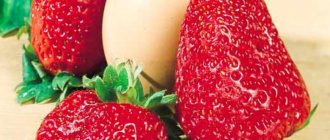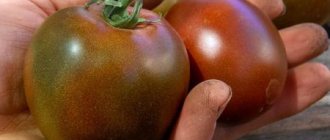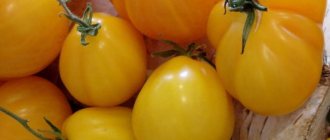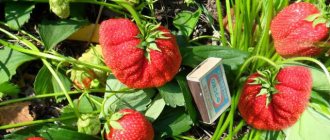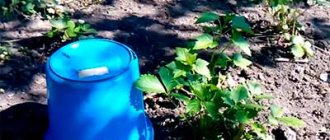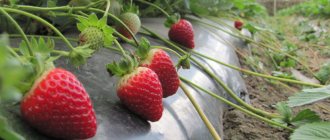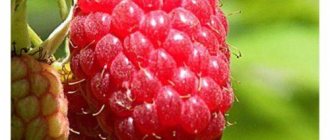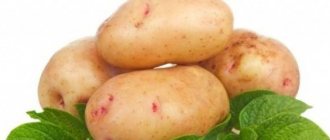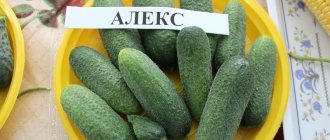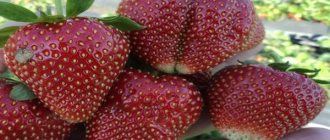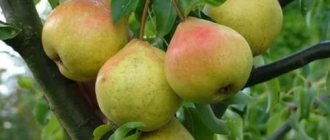Are you here
I would like to tell you about our method of growing strawberries, which we have been using for several years in our garden. We have 5 acres under this crop. We called our method “Strawberries under a fur coat.” It allows you to significantly reduce plant care work, increase productivity by 15-30%, and obtain clean, large berries of excellent taste in any weather. And its essence is as follows. As soon as the ground thaws, we remove dry leaves from the strawberry beds, loosen the soil around the plants to retain moisture in the soil, and feed them. Next, we carry out the first feeding of the plants with potassium-ammonium nitrate (according to the instructions on the package). Then, even before the buds open, we spray the plants with a 3-4% solution of copper sulfate. We also cultivate the soil around the bushes to destroy pathogens. After this, we cover the row spacing and the ground around the plants with a thick layer, at least 10 cm, of mulching material (we use wood shavings). The strawberry plantation seems to be wearing a fur coat. The main thing in this matter is to carefully cover the entire surface of the earth, and leave only the apical bud on the plants. 1 - 2 weeks after the first rains, the shavings cake so that most weeds cannot germinate, while water and fertilizing, on the contrary, freely pass to the roots of the plants. We do the second feeding at the beginning of May with complex mineral fertilizer “Strawberry Concentrate”, again according to the instructions on the package. To increase productivity, we make 2 more foliar feedings, spraying the plants at the beginning of flowering and during the growth of the ovaries with a 0.01-0.02% solution (1-2 g per 10 l of water) of zinc sulfate, to protect strawberries from returning spring frosts During flowering, when the temperature drops, we cover the plantation with film or spun-bond. We remove shelters after the threat of frost has passed. During flowering and ovary growth, if there is no rain, water the plants regularly once a week. We let the water flow between the rows and make sure that it does not get on the leaves and berries. We collect the berries in June in dry weather with the stalk and calyx. They are always clean, even after heavy rains. We regularly inspect the plantings, culling diseased and non-standard plants. We weed out rare weeds and remove tendrils that appear on fruit-bearing plantings. We do not remove the mustache on mother plantings. Immediately after harvesting, we mow down the old leaves to a height of 5-7 cm from the soil level and be sure to spray the bushes against diseases and pests and, of course, feed them with complex mineral fertilizer “Strawberry Concentrate”. Don't forget to water the plants regularly. All this helps to increase next year’s harvest by 10-15%. And one more nuance. I have long noticed that if you treat the plantings with a 0.3% urea solution in August, the production of flower buds for next year will increase significantly. Now about planting plants and preparing planting material. Here you need to remember three rules: first, we receive planting material from the mother area only during the first year; second, all planting material must be disinfected from diseases and pests before planting (I use thermotherapy). We make a bath for water heating of seedlings using 2 tanks installed one inside the other with a wooden spacer between them. We fill the inner tank and the spaces between them with water, then heat it to the required temperature. Cover the tanks with lids. The regime for treating plants in hot water against strawberry mite, strawberry nematode and stem nematode is as follows: temperature 47-48 C, treatment time 15 minutes. This treatment disinfects the plant by 95-98%. For thermotherapy, we select apparently healthy plants. Before warming up, we wash the seedlings and immerse them in hot water (no more than 2-3 plants per 1 liter), then remove them and cool them in water at a temperature of 10-15 C for 15-20 minutes. After this, we plant the plants in a permanent place. And the third, perhaps the main condition. The sooner we plant the plants, the better they will develop, and the greater the harvest we will get from them next year. All strawberry plantings in the summer must be completed before August 15, otherwise the plants will not take root well and may die in the winter. The best predecessors for strawberries are annual vegetable or flower crops. Before planting, add 10 kg of compost, 12 g of superphosphate, 15 g of potassium and 400 g of lime (if the soil is acidic) per 1 square meter into the soil. We cultivate the area and mark the planting sites with a marker. We usually use a one-line scheme with 60-70 cm between rows, a distance of 20-30 cm in a row. When planting in a hole, we straighten the roots of the plants evenly and cover them with loose fertile soil, while the apical bud should be at the level of the soil surface. We water the planted plants regularly until they are completely rooted. After the plants take root, after about 1-1.5 weeks, we cover all new plantings with a thick layer of wood shavings (at least 10 cm). This will prevent the appearance of weeds on young plantings, retain moisture in the soil and protect young plants from freezing in winter. On a strawberry plantation covered in this way, even in the absence of snow cover, I have not observed freezing over the last 4 years. Plants feel comfortable under such a “fur coat”. I would also like to note that it is advisable to grow strawberries in one place for 4 years. And in order to have a good and stable harvest of this crop every year, you need to devote 1/4 of your available area to new plants every year and dig up 1/4 of the old ones. For better decomposition of the mulching material in the soil, it is necessary to add a double rate of nitrogen per 1 square meter when digging up the vacated area from strawberries. Now I’ll tell you a little about the varieties of large-fruited garden strawberries. which we grow on our site and are satisfied with them.
Planting and care
Proper planting and proper care of strawberries is the key to a rich harvest. Next, we will consider the basic rules for planting and caring for the Black Swan variety. With these instructions, even a novice gardener can grow this plant at home.
Also read about how to plant strawberries under covering material.
Selection and preparation of a landing site
It is important that the site has plenty of sunlight and protection from drafts. As for the soil, the choice of most gardeners falls on light loam or sandy loam, chernozem. Clay soil, limestone and saline soils are not suitable.
Places where onions, garlic, various grains or marigolds were previously grown are suitable. It is not recommended to plant strawberries in one area for more than 3-4 years. Before the next planting, a break of 2-3 years is needed. Be sure to check the soil for acidity: a pH level of 5.5–6.5 would be ideal.
It is necessary to prepare the soil in advance, even before winter: add for digging for every 1 m² of soil:
- 1 kg of humus or 5 kg of manure;
- 100 g superphosphate;
- 50 g potassium salt.
Important! The groundwater level should not exceed a meter mark from the soil surface.
Material
One of the important points is the choice of good planting material. It is better that the seedling has fibrous roots with shoots of about 8 cm. The root collar should be about 6 mm in diameter. This mostly applies to purchased material that spent the winter in the cellar. It’s good if the seedlings have at least 5 leaves.
Landing rules
There are certain rules for landing a Black Swan:
- The selected bed must first be dug up.
- Dig shallow holes. The distance between bushes should be 30 cm, and between rows - 40–70 cm.
- If humus has not yet been added, you need to pour 20 g of this fertilizer into the holes, mixing it with the ground so as not to burn the roots of the seedlings.
- Place the bush in the hole. It is important that the roots do not bend, otherwise the bush will not bear fruit.
- Water the hole; it should be saturated with moisture. For 1 bush about half a liter of water, if the soil is dry - 1 liter.
- When the water is absorbed, fill the hole with soil without covering the rosette (apical bud) of the bush. It must be level with the ground, otherwise it will rot. If it is high, it will freeze in the cold.
- Compact the soil around the bush.
- Trim off the tendrils and damaged leaves, if any. Don't worry, the young plant will produce new ones.
- If planting occurs in rows, make grooves between them and water further into them. Water should not be poured on the plants to avoid the formation of a crust around the bush. It will not allow the plant to breathe.
- After watering, mulch (cover) the furrows with peat, hay or straw. Otherwise, you will have to regularly plow the furrows so that they retain moisture longer.
Strawberry planting scheme.
Watering and fertilizing
Seedlings need constant moisture. Proportion: 10–12 liters of water per 1 m². Take water at room temperature. The frequency of watering in cool weather is once every 10–12 days; if the summer is hot, then increase the amount to 3-4 times a week. In autumn, when the air is dry, moisturizing twice a week is enough. Watering is best done in the morning. Until the first flower stalks appear, it is better to use the watering method - sprinkling, and then - drip irrigation.
Important! Excessive amounts of moisture in the soil can lead to gray rot or root rot in the plant.
However, droplets should not fall on the plant. The main elements for nutrition of both the Black Swan and other varieties of strawberries are phosphorus, potassium and nitrogen. Phosphorus ensures the growth and strengthening of roots, affects the ripening of full-fledged fruits, as well as their quantity. Potassium and nitrogen are needed to gain green mass, but you cannot overdo it with them, otherwise the plant may not bear fruit.
Fertilizers themselves can be divided into three types:
- Organic means all products of animal origin (manure, bird droppings, ash and all kinds of composts).
- Minerals - nitrogen, phosphorus, potassium.
- Microfertilizers - used for spraying (magnesium, copper, boron, iodine).
Application procedure:
- The first fertilizing can be carried out at a soil temperature not lower than +8...+10°C, otherwise the root system will not absorb and assimilate fertilizers. It is at the moment when new leaves appear that the plant needs a lot of nitrogen.
- Next time you need to fertilize when the strawberries have buds.
- The third feeding is carried out when the strawberries bloom and bear fruit. During this period, it is necessary to fertilize with potassium and phosphorus so that the berries accumulate mass and are tastier.
- The fourth and final feeding is carried out closer to autumn, when the fruits have already been collected. This allows you to strengthen the plants before winter.
You will be interested to know how to use boric acid for strawberries during flowering.
Mulching and loosening
Covering the soil of seedlings with various materials is called mulching.
This provides a number of advantages:
- water from the soil evaporates more slowly, which reduces the number of waterings;
- the ground around the strawberry bushes does not heat up;
- weed growth slows down;
- there is protection against pests such as slugs and snails;
- soil structure improves;
- the fruits do not touch the ground - there is less risk of becoming infected with gray rot.
This procedure must be carried out twice a year: in May and October.
Straw, hay, pine needles, sawdust, humus, as well as agrofibre and cardboard are suitable. In hot weather, the mulch must be loosened. If parts rot, they must be replaced. Important! The needles will gradually increase the acidity of the soil due to the tannin content. It can only be used on slightly acidic soils.
It is important that the material does not lean against the stems of the plant. The black swan needs frequent loosening, preferably after rain or when weeds appear, at least seven times during the growing season.
Preparing for winter
Black swan is frost-resistant and can tolerate down to -25°C, but it is still necessary to take measures to protect the plant before winter. If the winter is snowy, then the snow itself will protect the plants from the cold - the soil under it will not freeze. If there is no snow, then you can make a shelter for the beds - leaves, hay, pine needles. The greatest danger is that such a shelter can accumulate moisture, which will cause the plant to rot and may even die. It is important to mulch and fertilize the seedlings before winter.
Video: preparing strawberries for winter
Black strawberries: appearance and taste
Hello!
I heard on TV that black strawberries have appeared in our country. Is it true? Is it possible to grow it in central Russia? Thank you. Black strawberries exist and are safe to eat.
In our country, gardeners are accustomed to growing and consuming varieties of this crop that produce red berries. However, today white and other varieties are gradually gaining positions on the plots and plates of summer residents.
This berry is considered to be and is called the Black Prince species. He is from America. This is the fruit of the activities of modern breeders. The fruits of this species are large, juicy in appearance and taste. It is a mistake to think that they are very dark in color in the usual sense of the word. No, the fruits have a rich dark red hue. By the time it is fully ripe, it actually looks like black. But the seeds of this still rare strawberry species are truly black.
Description of the variety
The description of the Black Swan variety should begin with the characteristics of the berry bush, which differ:
- leaves are slightly corrugated, glossy, medium in size;
- the shoots are strong, tall and have a fairly large number of ovaries;
- Strawberries during fruit ripening sometimes literally bend due to their weight, such is the volume of the harvest;
- A feature of the Black Swan variety is the small number of whiskers. The older the variety, the less mustache it forms in the future.
From the characteristics of the berries of the Black Swan variety, it is worth highlighting their bright, rich color. Perhaps it was thanks to him that strawberries received such a name.
- Black Swan fruits are so rich that from a distance it may seem like they are really black. Inside, the situation with the pulp is the same;
- The berries of the variety are large, often weighing up to 50 grams and have a glossy surface and a slightly truncated cone;
- the fruit pulp is rich and dense, which allows the variety to withstand any type of transportation at a reasonable level;
- The aroma of the berries gives off a little strawberry flavor, so it is easily remembered by ordinary people.
Characteristics of berries and bush
Berries can reach 70 g (average 30–40 g). They are considered small compared to a very similar variety - Black Prince (40–50 g). The fruits may taste like cherries, but everyone describes them as extremely tasty. The berries are elastic, round-conical in shape, with a strong gloss, dark red (sometimes they can appear black, which probably gave rise to the name of the variety), very beautiful. The pulp is dark, juicy and dense. The aroma gives off a little strawberry flavor.
Sometimes the fruits are so heavy, and their number is so large, that the bush bends under its own weight. The bushes are slender and tall, grow up to 60 cm and are very compact; have many peduncles with bluish flowers. The leaves are dark green, oblong-oval with uneven teeth along the edges. The root system lies deep in well-fluffed soil and reaches 50 cm. It produces few tendrils.
Main advantages
- Thanks to Dutch breeders, the developed variety has a number of distinctive qualities:
- resistance to fungal diseases;
- frost resistance;
- high productivity;
- long fruiting period;
- versatility of the variety;
- transportability.
Flowering period, ripening period, yield
In Black Swan, as in other mid- and late-ripening varieties, the first flower stalks appear in May, and the plant begins to bear fruit in June - July. The harvest can be harvested until September. This means that when all other varieties have already bloomed, the gardener will still be able to enjoy fresh berries from the garden.
The variety bears fruit well on fertile lands; on dry soils, the yield and size of the fruit are reduced. Under favorable conditions and proper use of agricultural technology, the yield from one bush can be up to two kilograms, which is considered a very good indicator for strawberries.
Resistance to diseases and pests
Black Swan is resistant to:
- late blight;
- verticillium;
- sclerotinia;
- gray rot.
Immunity to diseases is achieved by crossing high-quality varieties adapted to local conditions with productive forms of foreign selection that are immune or highly resistant to diseases and pests. This makes it possible to eliminate chemical protection from diseases and pests or significantly limit it, which makes it possible to reduce growing costs and obtain environmentally friendly products.
Advantages and disadvantages of the variety
- Among the advantages of the variety it should be noted:
- Black Swan has dense, elastic berries that are easy to pick and rarely wrinkle.
- The variety is not afraid of sudden frosts, which makes it a good candidate for cultivation in the regions of Russia and Ukraine.
- Black Swan is an unpretentious variety and its cultivation does not present much difficulty.
- The berries of this variety are considered one of the most beautiful; their glossy surface and dark shade make them attractive not only on the shelves, but also on the home table.
- However, there are a number of disadvantages:
- Late fruiting can be both an advantage and a disadvantage for the gardener. Therefore, the choice of variety must be approached carefully, first calculating the timing of planting and harvesting. The first ripening usually begins in July.
- Dry weather can significantly damage the harvest.
- It is worth noting that the Black Swan produces a mustache only after two years of growth. After that, their number will gradually decrease. This may be a disadvantage for those gardeners who prefer to propagate strawberries with tendrils.
Fruiting time
Strawberry Black Swan is considered a medium-ripening variety with a fairly long fruiting period. The first ripening of the fruits occurs in June, and they bear fruit throughout the summer. The maximum yield that could be collected from the berry is 1.2 kg. Another unique difference between strawberries is the fruiting period. If for an ordinary berry it is 5-6 years, then the Black Swan can bear fruit with quality care for up to 7 years.
Harvest and storage
It is important to harvest on time - the berries should not become too soft or lose their shape. If they are going to be transported, it is better to harvest the crop a little unripe. The berries need to be cut together with the calyx and stalk, so they will be stored longer. It is better to use scissors, because when torn off, the fruits may become wrinkled. The harvested crop is stored in wooden boxes in two or three layers - this is no longer recommended, so that the lower berries do not get crushed.
You need to sort and sort the berries during the picking process, because spilling the harvested crop is unacceptable - the berries wrinkle very easily. It is better to collect in the morning, when the dew has subsided. This way the strawberries will still be dense and dry. The harvested crop must be cooled to 0°C without delay. At this temperature, it can last in the refrigerator for up to three, maximum four days. Strawberries do not ripen in storage and do not improve over time, so they must be consumed or sold as soon as possible.
Also, do not leave the berries wet. With these tips, you can grow and enjoy a variety like Black Swan yourself. It can be successfully sold; tasty and beautiful berries are in demand on the market. It is unpretentious, so any gardener, following the rules of agricultural technology, can cope with planting this variety.
source
Tips for choosing a place to plant strawberries
The most suitable time for planting berries is late autumn, but not later. If the climate is suitable, planting in early spring is acceptable.
The fruiting of a plant directly depends on the correct choice of soil. Ideally, loose soil with good air permeability is required. You can choose loose loam, chernozem or forest-type gray soil. If there is a priori chernozem soil on the site, it should be diluted with river sand.
Important! In heavy soils, Black Swan strawberries will not germinate due to excessively rapid rotting of the root system.
Ideally, the growing area should be well lit and protected from cold winds. If at least minimal protection is not installed, the strawberries will freeze even with a light north wind. This happens with strawberries due to the fact that in winter there are sometimes such strong winds that they tear off not only the snow cover from the roots, but also the mulch. With proper protection, the variety can withstand even the harshest winters.
Features of cultivation
To plant Black Swan strawberries, gardeners recommend choosing late autumn. If the climate is favorable for growing the variety, then some of the seedlings can be planted in the spring.
Important! The high rate of strawberry fruiting depends on the quality of the soil on the site.
The soil for the crop should be loose and non-clayey. When growing Black Swan strawberries, high soil permeability is required.
Experts recommend chernozem, gray soil or light loam for planting. If the soil on the site is heavy and clayey, then sand and peat are added to it during preparatory measures. Additionally, fertilizers are buried.
Attention! Clay soil promotes rotting of the root system, so it will not be possible to grow Black Swan strawberries in such an area.
Another requirement is good illumination of the bed. The more sunlight, the higher the yield. The absence of ultraviolet radiation also affects the taste of the berries. During the rainy season, they become watery, sour, and take a long time to ripen.
Black Swan strawberries are recommended to be grown in areas protected from drafts and wind. If you do not provide shelter from air masses, then in winter some of the bushes may suffer. After all, the wind blows away not only the snow cover, but also the mulching materials.
Site preparation
Algorithm for carrying out preparatory work:
- A few weeks before the planned planting date, you need to dig up the soil.
- During the loosening process, fertilizers are added to the soil. You can use rotted manure, bird droppings, and herbal infusions. When planting in spring, nitrogen compounds are used.
- Be sure to control soil acidity. The culture requires soil with a neutral or slightly acidic reaction. To reduce acidity, dolomite flour is added to the soil. Manure, compost, and peat are added to alkaline soil. You can increase acidity using sulfates and nitrogen fertilizers. Ammonium sulfate or ordinary sulfur is often used.
The correctness of planting determines whether the bushes will take root and how quickly they will grow.
General planting recommendations
Make a ridge 30 cm wide. The distance between adjacent rows should be at least 60–70 cm. A gap of 30–40 cm is maintained between bushes. You can plant in holes, they should be shallow. The earth is watered.
The roots of each strawberry bush are straightened before planting.
The seedlings are lowered into the hole. Cover with soil without covering the apical bud of the plant. It should be at ground level. When buried, strawberries can rot, and when raised too high, they can freeze in cold weather.
The soil around the plant is gently pressed down with your hands. Water the soil around the seedlings, preventing moisture from getting on the foliage.
Planting holes or furrows are mulched with available materials. For these purposes, peat, straw, shavings, and mown grass are used. Less weeds grow under cover.
Mulch protects the soil from drying out and reduces the number of waterings
Attention! If during planting some leaves of the Black Swan strawberry are damaged, they must be cut off with a sharp knife or scissors. The plant quickly recovers and puts out new shoots.
Watering
Young specimens of Black Swan strawberries need regular moisture. For 1 m² of area you will need 10 liters of settled warm water. If the weather is warm and there is no scorching sun, then it is enough to moisten the plants once a week. In hot weather, the amount of watering is increased to 3-4 times. In autumn, the bushes are moistened once every four days.
Water in the morning (before sunrise) or late in the evening.
Sprinkling is used before flowers and fruits appear.
After the formation of ovaries on strawberries, use only drip watering.
Excessive moisture of tops and flowers can lead to the development of fungal diseases.
Attention! Waterlogging of the soil is fraught with root rot and crop loss.
Fertilizing
Without adding nutrients, it is difficult to grow Black Swan strawberries and get a decent harvest. Potassium and nitrogen are needed to form tops. They are introduced in the spring. Phosphorus affects fruit ripening and is used in the summer.
Preparing for winter
The characteristics of the Black Swan strawberry indicate that the crop normally tolerates frosts down to minus 20°C. But due to the lack of snow cover or significant temperature fluctuations, the plant may suffer. Therefore, in late autumn, beds with strawberries must be mulched. The thickness of the layer depends on the climate in the region. The colder it is, the thicker it should be.
Treatment against diseases and pests
Chemicals and folk remedies are used to protect strawberries from diseases.
Effective in the fight against fusarium, rot and anthracnose: Fundazol and Bordeaux mixture. For late blight, Nitrafen and Oxychom are used. For powdery mildew - a solution of iodine (1 mg per 1 bucket of liquid) or soda ash (50 g per 10 l).
If root rot is detected, strawberries are recommended to be dug up and burned. Treat the area with potassium permanganate and Bordeaux mixture. Plant the strawberries in another bed.
For pests use Fufanon, Kemifos, Actellik, Calypso, Karate.
Preparing seedlings and beds
As mentioned earlier, if the Black Swan variety is planted and prepared for planting correctly, the harvest will be rich and tasty. In order to properly organize the strawberry harvest, you need to carry out the following work:
- In a few weeks, it is necessary to dig up a ridge up to 30 cm. At the same time, it is necessary to fertilize the soil with humus or manure. Using manure, you can loosen the soil for planting the Black Swan variety and saturate the soil with nutrients, which will improve its fertility.
- To make weed control more effective, you can fertilize the bed before planting using a herbicide suitable for the variety.
- Before planting Black Swan, it is important to check the acidity of the soil. Soil with neutral or weak acidity is especially suitable.
- A couple of days before planting the berries, they should be soaked in Epin solution. This secret can stimulate further growth of strawberries. If there is a need to disinfect the soil, a solution of potassium permanganate is suitable.
Advice! If you need to adjust the acidity of the soil, you can use available materials. For example, to reduce it, some gardeners use dolomite flour. And when acidity increases, the method using ligin has earned positive reviews.
Diseases and pests
Even the Black Swan variety, resistant to major diseases, is often affected by diseases and pests. Next, the most common of them will be discussed, with methods of their treatment and prevention.
Diseases:
| Disease | Sustainability | Treatment |
| Late blight | Highly resistant | The use of chemical preparations “Nitrafen”, “Kuprosat”, “Oxychom”. Treatment with nettle infusion - 1.5 kg of leaves per 10 liters of water. After a day of infusion, the decoction is ready for processing the bushes. |
| Fungal diseases (gray and white rot, anthracnose, fusarium) | Highly resistant | Removing affected plants. Spraying with 0.2% foundationazole or 1% Bordeaux mixture once every 10 days. |
| Powdery mildew | Unstable | Treating bushes with soda ash - 50 g per 10 liters of water. Spraying with iodine solution - 1 mg per 10 liters of liquid. |
| Black rot | Unstable | There is no treatment. It is necessary to collect and destroy all the berries affected by the disease. |
| Root rot | Unstable | There is no treatment. Plants are dug up and destroyed. The soil is disinfected. |
| Verticillium (wilt) | Moderately stable | Fungicides will help only at the initial stage. Next - just change the planting material. |
Parasites:
| Pest | Sustainability | Treatment |
| Nematode | Highly resistant | Treatment with nematicides. You can also dig up a bush, wash the roots from the soil and place them in water with a temperature of +47...+55°C. Higher temperatures can cause irreparable damage to the roots. Processing time is from 5 to 20 minutes. |
| Strawberry mite | Moderately stable | In the southern regions, the predatory mite neoseiulus cucumeris is released onto damaged bushes. Also, the drugs “Fufanon”, “Kemifos”, “Aktellik” help against strawberry mites. |
| Aphid | Unstable | Aphids are eaten by birds, ladybugs and wasps. Solutions “Zolon”, “Karate”, “Shar Pei” performed well. |
| Earthy weevil | Unstable | Spraying strawberries with a 0.3% emulsion of 50% karbofos, while 30 grams of the drug must be diluted in 10 liters of water. |
| Strawberry whitefly | Unstable | The drugs “Shar Pei”, “Nurell D”, “Karate” have proven themselves well. |
| Bronzovka | Unstable | "Calypso" is one of the few drugs that destroy bronzes. |
1 - Nematode on strawberries; 2 - Main signs of the presence of strawberry mite; 3 - Aphids on strawberries; 4 - Earthy weevil; 5 - Bronzovka.
There are also general methods for preventing diseases and pests:
- Growing only strong and healthy Black Swan seedlings purchased from trusted places.
- Cultivation in one place for no longer than 2 years, not taking into account the year of planting. The older the berry plant, the more diseases there are.
- The width of the planting strip should not exceed 25–30 cm, since the leaves need sun and an influx of fresh air.
- Constant weeding of weeds and grass. They are the ones that cause most diseases.
Did you know? The world's largest producer of strawberries is the American state of California, where up to 1 million tons of these berries are harvested annually. Moreover, the entire world strawberry market is 4.3 million tons.
